
The COVID-19 pandemic ushered in a new age. Nothing has been the same since the pandemic, and even though we have reached a point where we can leave our homes comfortably, meet up with friends and family, and go about unmasked – we’re still feeling the effects of the pandemic.
Not only has there been a very dramatic shift in how people interact with their jobs, but there has been an overall decline in physical and mental health since the pandemic. However one of the foremost problems that Australia has had to face due to the pandemic is the issues in our healthcare supply chain.
A supply chain is how resources or products get from their origin to their manufacturer, to the people. So supply chain management skills as well as the efficacy of the supply chain’s infrastructure and efficiency are all the forces behind getting bread from the supermarket or petrol from the petrol station.
It can be easy to forget, as we don’t think about it all the time, but most of those trucks you see on the road in the morning are usually part of one supply chain or another. However, the pandemic has highlighted some very significant issues with arguably one of Australia’s most important supply chains, healthcare.
Supply chains are the critical links to getting a civilisation the supply that it needs for its people to live comfortably and well – however when one of these chains has delays or issues, that directly affects almost every member of that civilisation. When a healthcare supply chain isn’t living up to its maximum efficiency however, it can be a matter of life and death, as the availability of vital drugs, hospital equipment, and healthcare tools declines, so too does the quality of life of the people who need these things.
COVID-19 boosted excess mortalities in Australia to numbers that haven’t been recorded since WWII. More than 50% of these excess deaths (20,000) were caused by the virus in 2022, long since the virus reached its fever pitch in 2019-2020.
Not only that but the stress of working in the COVID-era healthcare system caused many nurses, doctors, and other healthcare professionals to leave their positions, stressed and burned out from the overwhelming number of cases; and from the vicarious trauma of seeing so many deaths in so little time.
People in regional areas have been particularly affected by this new shortage of healthcare staff, but the shortages of staff have been exacerbated by flaws in the healthcare supply chain. Overwhelmed by the rapid increase in demand for medical attention, supplemented by the decrease in qualified staff to provide that attention, COVID-19 revealed deep flaws and insecurities in Australia’s healthcare supply chain.
The chief issue with Australia’s supply chain is that it is exceedingly long. We are a small nation, reflected in our contribution to the global healthcare industry. Currently, Australia represents merely 2% of the global pharmaceutical market, importing over 90% of our available medicines as we lack the supply to consistently produce our own. Another issue is that despite some medicines demanding supply all over the nation, these medicines are often only imported to one location, meaning that all the logistic strain of acquiring that medicine is put in a single place. If that one place slows down, there is no backup solution.
Another major issue is that since we import nearly all of our medicine if another country is suffering a shortage of a particular pharmaceutical resource due to famine, drought, war, or epidemic, then our country will also undergo a shortage of that resource.
Our healthcare supply chain has many other issues, but in short, our nation is heavily reliant on other countries for medical supplies, we are at the end of a very long global supply chain, and a reliable supply of medicines and healthcare resources is reliant on consolidated import locations, and geopolitical stability. Considering the overall lack of stability from the so-called “COVID hangover,” things can seem pretty bleak.

Despite the issues that have been evidenced, it appears that things are on the mend. Although Australia’s supply chains have several critical issues, the chaos of the COVID-19 pandemic illustrated exactly what they are, and policymakers have been working to try and address them.
The supply issues caused quite a dip in the efficacy of our Aged Care sector, however, presenters at the 8th PASA Annual Health & Aged Care Procurement Conference’ in Sydney yielded optimistic findings. It was made clear that although supply chains are still sluggish from the tumult that was COVID-19, ultimately things are getting better. Aged Care providers can again procure the necessary medicines and equipment, and even if their primary supplier is unable to meet demand, finding a secondary supply is relatively easy.
All in all, things are better than they have been, but they’re still not great. While COVID-19 continues to affect the world despite available medicines and treatment, it revealed a lot of weaknesses in the Australian healthcare supply chain, and although efforts are being made to optimise, experts have criticised attempts as being too little; expressing the sentiment that we shouldn’t be trying to bring supply chains back to pre-COVID standards, but should be attempting to revitalise the supply chain as a whole so that the current issues are no longer a threat.
It is important to remember that we’re still feeling the global burnout of the pandemic and that before things can be improved, they first need to get back to normal. Two pieces of information are critical to focus on with this issue. The first is that despite issues with the supply chain, we’re on the way to getting things as they were. The second is that due to COVID-19, we are now aware of what those issues are, and can work on fixing them.